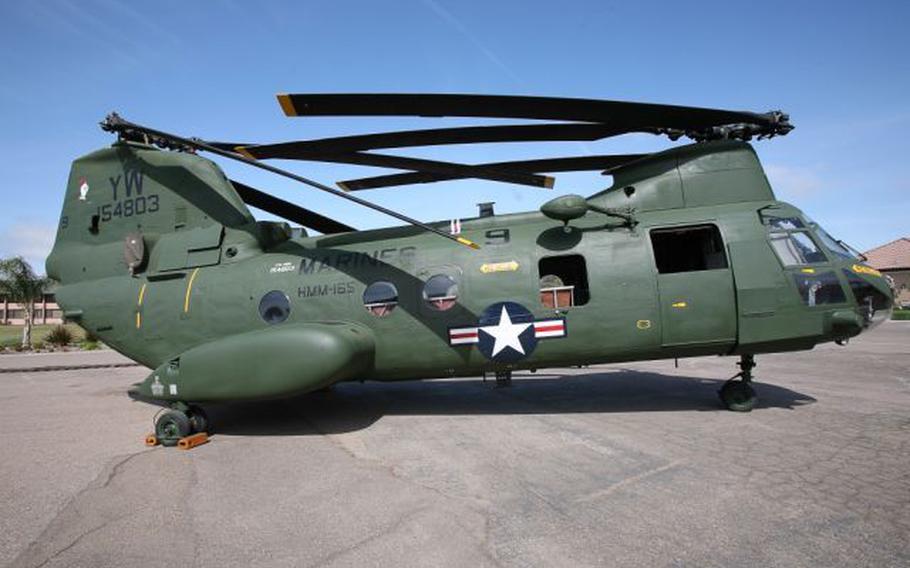
“Lady Ace 09,” a CH-46E “Sea Knight” helicopter at the Flying Leatherneck Aviation Museum, was repainted and remarked in 2010 by Marine Medium Helicopter Squadron 165 airframes Marines. The restoration updated the helicopter to look as it did during the evacuation of the Vietnam ambassador during the fall of Saigon. (Sean McGinty/U.S. Marine Corps)
(Tribune News Service) — The CH-46 helicopter that evacuated the ambassador and flag from the roof of the American embassy during the fall of Saigon in 1975 may soon take a new journey, landing at the Irvine Great Park in California.
The helicopter and another 40-plus aircraft of the Flying Leatherneck Aviation Museum in San Diego could soon be on display in a newly restored hangar once part of the Marine Corps Air Station El Toro.
The base was the original home of the aviation museum when it was active in the late 1980s. Since then, the artifacts of American aviation have been housed at the Marine Corps Air Station Miramar.
Discussions between the Marine Corps, the Flying Leatherneck Historical Foundation and the city of Irvine are progressing for the museum to move to Orange County, and officials expect an agreement soon that would result in a public/private partnership where the Marines would loan the aircraft and artifacts for display in the Great Park hangar.
“We are now collaborating with the Marine Corps on a draft memorandum of understanding that will allow for the Marines to lend the aircraft once the city and the foundation are able to ensure proper security and safety,” said retired Marine Brig. Gen. Mike Aguilar, executive director of the museum’s nonprofit foundation. “In discussions, we’ve received their (Marines) 100% commitment to this project.”
Camp Pendleton officials confirmed the service branch is “prepared to loan aircraft and smaller artifacts” when it “becomes a viable museum and is able to properly care for the artifacts.”
In the meantime, the Corps will maintain its aircraft at Miramar; ship smaller artifacts to the National Museum of the Marine Corps to be cataloged, preserved and stored; and ship the archival material to the Marine Corps History Division to be cataloged, preserved and stored.
“Our goal is to meet and exceed their requirements,” Aguilar said of plans for the Great Park museum.
The proposed location is in an old Marine Corps hangar built during World War II known as Hangar 296 that is on the eastern edge of the Great Park. The hangar is large enough to house all of the aircraft and the memorabilia.
Engineers are looking at what restoration of the hangar will entail, estimated to cost about $14 million, Irvine officials said. Essentially Irvine would be the landlord for the museum.
Mayor Farrah Khan said getting the museum to the Great Park is “very significant” for the city.
Many of the aircraft in the collection were already part of the museum while it was still part of the El Toro base.
“It will be like they are coming home,” she said. “As we develop the Great Park, knowing how it came to be is so important.”
The interior design and museum exhibit will be left for the foundation to develop. Some funding for the museum could come from private donations or corporate sponsorships.
“I’m excited about the collegiate effort between the Marine Corps, the foundation and Irvine to bring home the Flying Aviation Museum to the former Marine Corps Air Station El Toro,” Aguilar said.
The museum, which at El Toro was the El Toro Historical Foundation and was under the leadership of Brig. Gen. Jay Hubbard, moved to Miramar in 1998 when the base was decommissioned.
Hubbard’s vision was to preserve and tell the rich history of Marine Corps Aviation on the West Coast, which dates to 1920. Most of the Corps’ aviation forces that have deployed to combat and other contingencies have been trained at Southern California’s constellation of air stations and facilities since the ’20s.
The museum’s collection of aircraft, exhibits and archives were moved down to a site on Miramar Road adjacent to the air station. There, over the years, the collection of aircraft grew to more than three dozen historical aircraft, some of them unique to the Marine Corps.
Amid budget constraints, the Miramar base closed the museum in 2020. Aguilar said the foundation was approached by Irvine about moving it back to where it was first established in the late 1980s.
The museum collection, actually owned by the National Museum of the Marine Corps, is considered to be the only collection dedicated to Marine Corps aviation.
One of them, an Iraqi Bell 214 ST assault helicopter, was captured and acquired by retired Marine Colonel Charles Quilter, of Laguna Beach, following the 1st Marine Division’s seizure of the Kuwait International Airport during Operation Desert Storm in 1991.
Quilter, an aviator and historian who flew F-18s for decades in the Marines, is thankful plans for the museum are moving forward.
“As part of its planned Cultural Terrace, the city of Irvine is really stepping up to turn a vast historic hangar into what will be Orange County’s largest aviation museum, in terms of square footage,” he said. “More importantly, the story of the role of Marine Corps aviation in Southern California will not only be preserved, but told well. I’m hoping that modern museum design will make it an experience worth going to.”
©2022 MediaNews Group, Inc.
Visit ocregister.com.
Distributed by Tribune Content Agency, LLC.